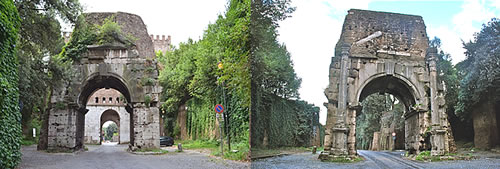Arch of Drusus

Historical sources tell us that the Senate had erected along the Via Appia a arch in honor of Drusus in 9 BC, was a post-mortem recognition by the triumphs that the young Roman general had achieved in the campaigns against the Germans.
Drusus was the youngest son of Livia, born shortly before she became the wife of Augustus; events so close together gave rise to gossip and there were people who believed that Augustus was the natural father. Augustus had great affection for Drusus and followed the cursus honorum anticipating the times and giving him as his wife Antonia Minor, the daughter of his sister Octavia.
Drusus was a brave and successful general, beloved by legions but her life was broken to 30 years by a fall from his horse while he was in Germany; Augustus, although it was winter, he went to Pavia meet the the body and did not seceded until Rome.
The Drusus body was cremated in the Campus Martius and the ashes deposited in the Mausoleum of Augustus; many monuments were dedicated to honor him including the Cenatafio erected by his soldiers in Mainz, the Drusion, a tower located in the city of Caesarea in Palestine, and especially the triumphal arch erected on the Via Appia. The arch construction was decreed by the Senate but it's hard to believe it was not an initiative of Augustus as it was to honor a member of his family.
Suetonius, in Life of Claudius, describes the event "Praeterea Senatus inter allia complura marmoreum arcum cum tropheis Via Appia decrevit et Germanici cognomen ipsi, potserique eius".
The Drusus arch is located immediately before the Porta S. Sebastiano; It appears today as one of the arches of the aqueduct Antoniniano realized in the time of Caracalla to feed the famous Termae; in reality as in other monuments - such as Porta Maggiore - at the point where the aqueduct had exceeded the Appian Roman engineers leaned the aqueduct conduits above the attic arc. During the restoration wanted by Onorio the arc was also incorporated with Porta S. Sebastiano in a sort of defensive castle.
Some indication of the original characteristics of the arc is given by the coins that Emperor Claudius, son of Drusus, minted in 44 A.D. From money it is derived a representation of arc with four columns on each side, two larger and two smaller, four windows, as a frontispiece and over by an equestrian statue of Drusus between two trophies; of all the decoration Today remain only two columns placed on high plinth which frame of the side facing the outside of the city, and part of the triangular pediment.
Another story of the monument disputes that it is the Arch, which was erected in the first century. BC, it would be another arc located in a arch of the aqueduct in the third though. A.D. of which has not yet been possible to have a certain attribution. The original Arch of Drusus should have been scrapped and its decorations used againso, it is possible that the two existing columns on the arch visible today were part of spolio materials.
The emperor Honorius in the fifth century. to improve the fortification of Rome's city wall, constructed two arms to join the Arch to Porta San Sebastiano in order to get a real fort where it could be controlled the port transit : those entering was checked in the fortified courtyard and only after it was open the inner door placed in the fornix of the Drusus Arch.
Above the ancient arch in the Middle Ages it was also built a tower which today remains only a few rows of tuff bricks.
by M.L. ©ALL RIGHTS RESERVED (Ed 1.0 - 27/09/2016)






